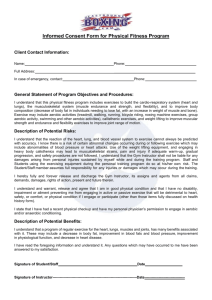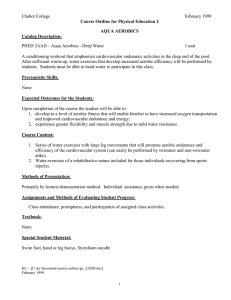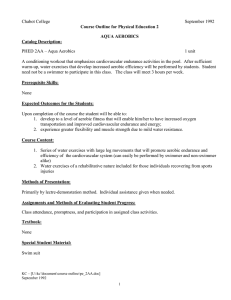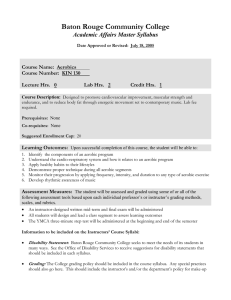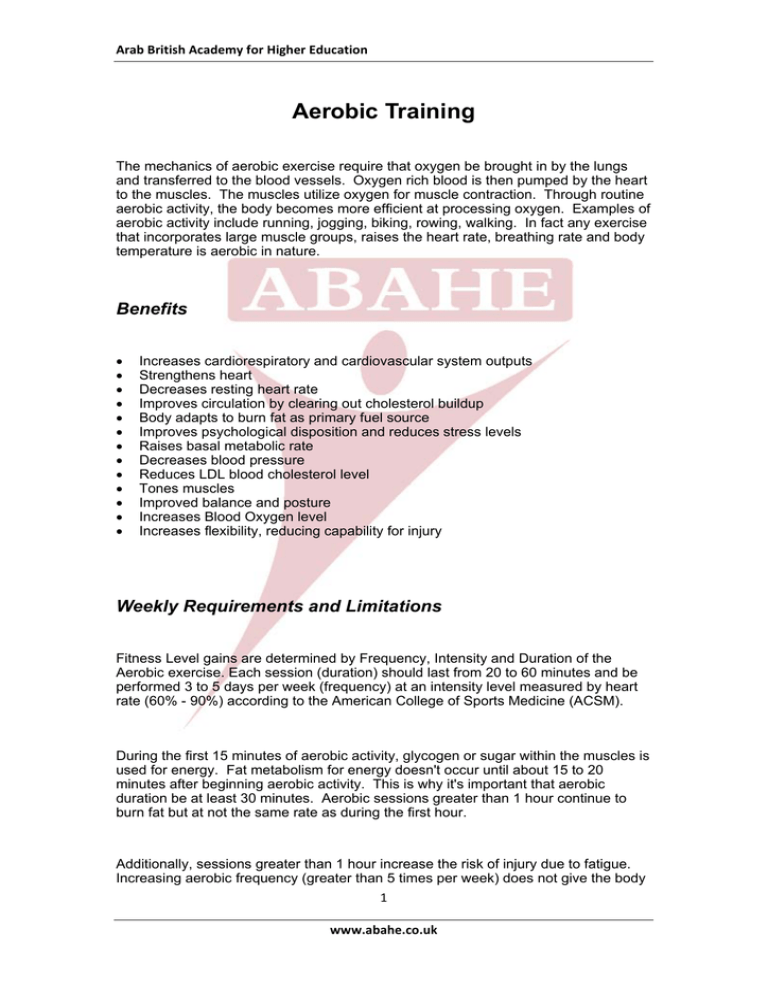
Arab British Academy for Higher Education Aerobic Training
The mechanics of aerobic exercise require that oxygen be brought in by the lungs
and transferred to the blood vessels. Oxygen rich blood is then pumped by the heart
to the muscles. The muscles utilize oxygen for muscle contraction. Through routine
aerobic activity, the body becomes more efficient at processing oxygen. Examples of
aerobic activity include running, jogging, biking, rowing, walking. In fact any exercise
that incorporates large muscle groups, raises the heart rate, breathing rate and body
temperature is aerobic in nature.
Benefits
Increases cardiorespiratory and cardiovascular system outputs
Strengthens heart
Decreases resting heart rate
Improves circulation by clearing out cholesterol buildup
Body adapts to burn fat as primary fuel source
Improves psychological disposition and reduces stress levels
Raises basal metabolic rate
Decreases blood pressure
Reduces LDL blood cholesterol level
Tones muscles
Improved balance and posture
Increases Blood Oxygen level
Increases flexibility, reducing capability for injury
Weekly Requirements and Limitations
Fitness Level gains are determined by Frequency, Intensity and Duration of the
Aerobic exercise. Each session (duration) should last from 20 to 60 minutes and be
performed 3 to 5 days per week (frequency) at an intensity level measured by heart
rate (60% - 90%) according to the American College of Sports Medicine (ACSM).
During the first 15 minutes of aerobic activity, glycogen or sugar within the muscles is
used for energy. Fat metabolism for energy doesn't occur until about 15 to 20
minutes after beginning aerobic activity. This is why it's important that aerobic
duration be at least 30 minutes. Aerobic sessions greater than 1 hour continue to
burn fat but at not the same rate as during the first hour.
Additionally, sessions greater than 1 hour increase the risk of injury due to fatigue.
Increasing aerobic frequency (greater than 5 times per week) does not give the body
1 www.abahe.co.uk Arab British Academy for Higher Education a chance to fully recover and can even reduce the body's capability to defend itself
against illness. It is important to listen to what your body is trying to tell you. Rest,
adequate sleep, proper diet all become more critical when demands are placed on
our bodies above the normal everyday physical stress.
Diet Requirements
The type of fuel you put in a vehicle depends on the performance you expect out of it.
The same is true of our body. Unlike weight training, aerobic training has two main
goals. The first is to improve cardiovascular performance, the second to burn fat.
Both of these goals can be realized during the same aerobic session.
If the goal is to simply improve cardiovascular strength then we need to target
performance. Like weight training, we want to consume a complex carbohydrate
snack before aerobics. A sugar snack will not provide the sustained energy and in
fact may decrease performance. Excessive sugar intake before aerobic activity can
work against the participant. When large amounts of sugar are ingested, the
pancreas must secrete insulin to metabolize the sugar. Insulin levels in the blood
inhibit the liver from metabolizing fat. Therefore little or no fat burning takes place
during exercise. This includes sugary drinks, i.e., sport drinks which, stay in the
stomach much longer than ordinary cold water thereby inhibiting quick hydration.
Therefore, if the goal is to burn fat, then water only should be consumed before
aerobics.
All Rights Reserved © Arab British Academy for Higher Education 2 www.abahe.co.uk


